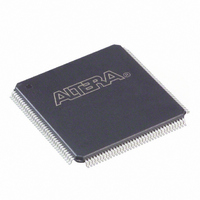EP1C3T144C7 Altera, EP1C3T144C7 Datasheet - Page 36

EP1C3T144C7
Manufacturer Part Number
EP1C3T144C7
Description
IC CYCLONE FPGA 2910 LE 144-TQFP
Manufacturer
Altera
Series
Cyclone®r
Datasheet
1.EP1C3T144C8.pdf
(106 pages)
Specifications of EP1C3T144C7
Number Of Logic Elements/cells
2910
Number Of Labs/clbs
291
Total Ram Bits
59904
Number Of I /o
104
Voltage - Supply
1.425 V ~ 1.575 V
Mounting Type
Surface Mount
Operating Temperature
0°C ~ 85°C
Package / Case
144-TQFP, 144-VQFP
Family Name
Cyclone®
Number Of Logic Blocks/elements
2910
# I/os (max)
104
Frequency (max)
320.1MHz
Process Technology
0.13um (CMOS)
Operating Supply Voltage (typ)
1.5V
Logic Cells
2910
Ram Bits
59904
Operating Supply Voltage (min)
1.425V
Operating Supply Voltage (max)
1.575V
Operating Temp Range
0C to 85C
Operating Temperature Classification
Commercial
Mounting
Surface Mount
Pin Count
144
Package Type
TQFP
Lead Free Status / RoHS Status
Contains lead / RoHS non-compliant
Number Of Gates
-
Lead Free Status / Rohs Status
Not Compliant
Other names
544-1051
Available stocks
Company
Part Number
Manufacturer
Quantity
Price
Company:
Part Number:
EP1C3T144C7
Manufacturer:
ALTERA
Quantity:
624
Company:
Part Number:
EP1C3T144C7N
Manufacturer:
ALTERA
Quantity:
250
Part Number:
EP1C3T144C7N
Manufacturer:
ALTERA/阿尔特拉
Quantity:
20 000
Cyclone Device Handbook, Volume 1
Figure 2–22. Global Clock Generation
Notes to
(1)
(2)
(3)
2–30
Preliminary
CLK1 (3)
DPCLK1
DPCLK0
CLK0
The EP1C3 device in the 100-pin TQFP package has five DPCLK pins (DPCLK2, DPCLK3, DPCLK4, DPCLK6, and
DPCLK7).
EP1C3 devices only contain one PLL (PLL 1).
The EP1C3 device in the 100-pin TQFP package does not have dedicated clock pins CLK1 and CLK3.
Figure
2–22:
Cyclone Device
PLL1
The eight global clock lines in the global clock network drive throughout
the entire device. The global clock network can provide clocks for all
resources within the device—IOEs, LEs, and memory blocks. The global
clock lines can also be used for control signals, such as clock enables and
synchronous or asynchronous clears fed from the external pin, or DQS
signals for DDR SDRAM or FCRAM interfaces. Internal logic can also
drive the global clock network for internally generated global clocks and
asynchronous clears, clock enables, or other control signals with large
fanout.
network.
2
DPCLK2
DPCLK7
Figure 2–22
From logic
array
Note (1)
4
4
shows the various sources that drive the global clock
8
4
From logic
DPCLK6
array
4
DPCLK3
Global Clock
Network
2
PLL2
(2)
Altera Corporation
May 2008
DPCLK4
CLK2
CLK3 (3)
DPCLK5














